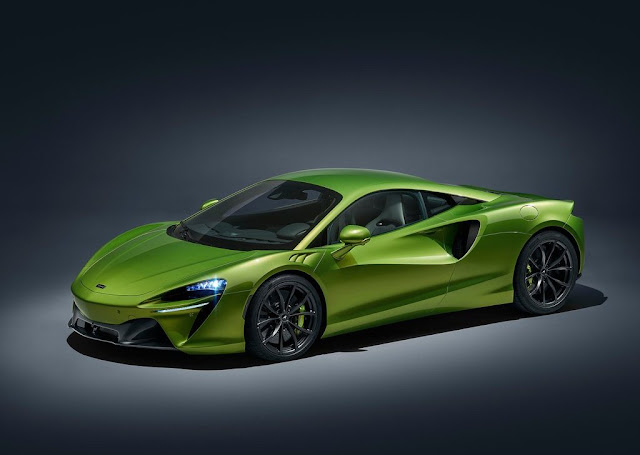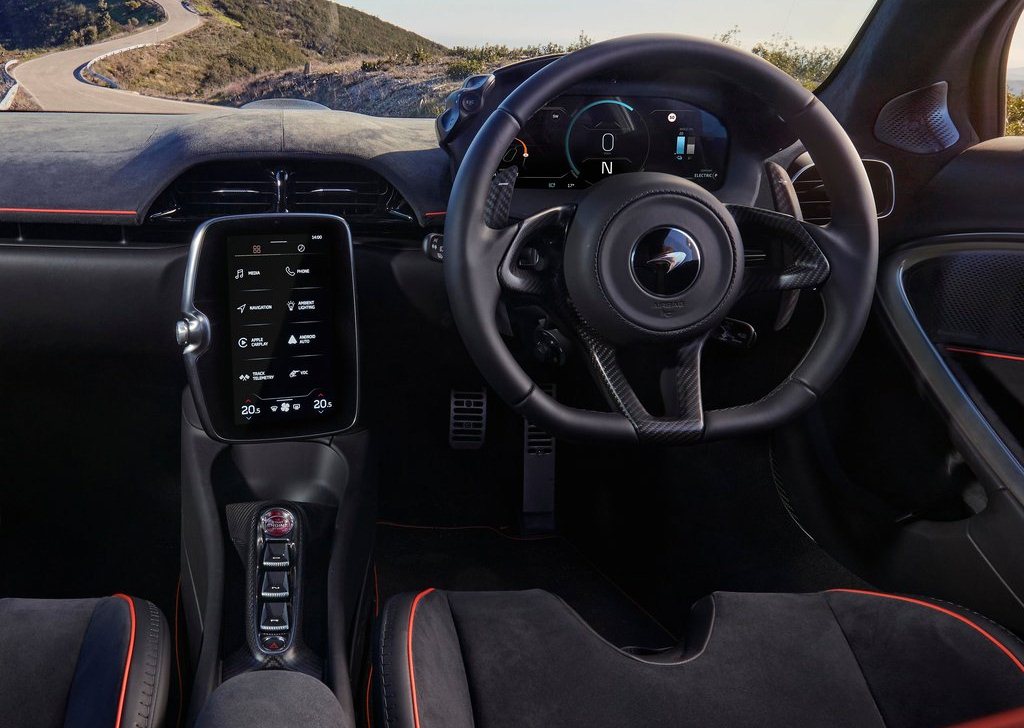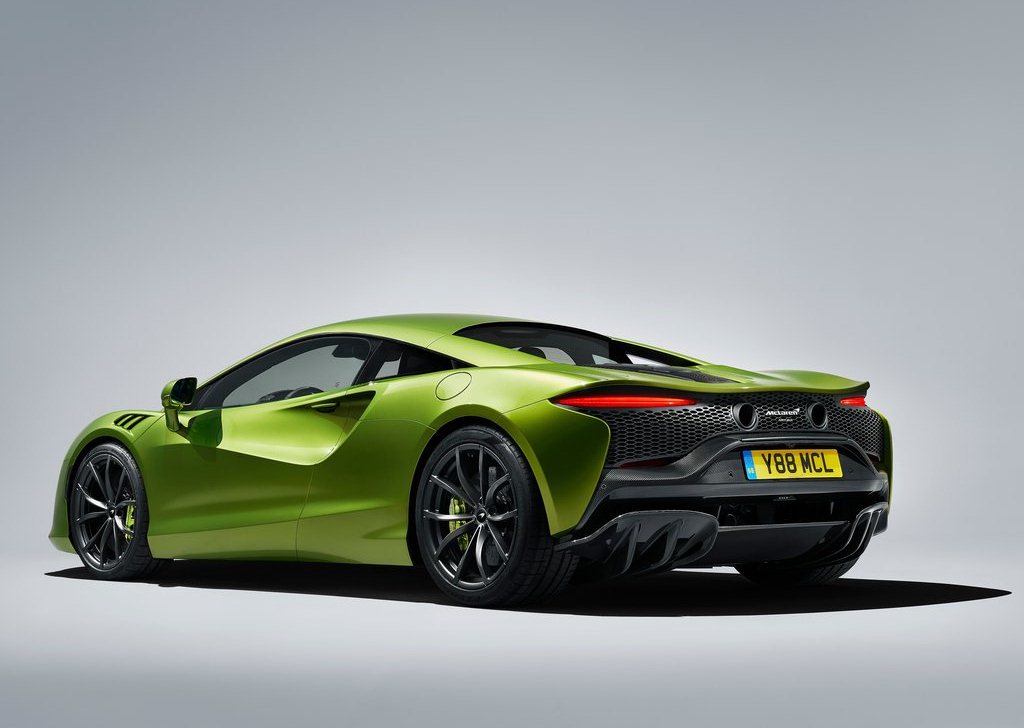The all-new McLaren Artura marks the beginning of both a new chapter for the pioneering luxury supercar company and a new era in supercar technology and performance.
McLaren's first series-production High-Performance Hybrid supercar focuses more than half a century of the company's racing and road-car experience and expertise into a next-generation supercar that blends ground-breaking technology with McLaren's dedication to pure driver engagement.
Underpinned by the McLaren philosophy of super-lightweight engineering, the all-new Artura is the distillation of every attribute inherent in a McLaren - distinctive design, unrivalled performance, dynamic excellence and engineering innovation - with electrification now bringing the additional benefits of even faster throttle response, lower emissions and being able to run in pure EV mode for emissions-free journeys of up to 30km.
All-new from the ground up, the Artura presented McLaren engineers and designers with new opportunities to innovate, chief among these being how to preserve McLaren's super-lightweight engineering philosophy when adding hybrid powertrain elements including an E-motor and battery pack.
A demanding programme of weight reduction, encompassing every area of the McLaren Artura from the chassis platform - this is the debut of the new McLaren Carbon Lightweight Architecture (MCLA) - through the uniquely compact HPH powertrain system to the weight of cabling used in the electrical systems (where a 10% reduction was achieved), resulted in the Artura having a lightest dry weight of 1,395kg.
The total weight of hybrid components is just 130kg (which includes an 88kg battery pack and 15.4kg E-motor), resulting in a DIN kerbweight of 1,498kg which is on par with comparable supercars that do not have hybrid powertrains, giving the Artura a super-lightweight advantage.
The McLaren Artura: in detail
Every drop of McLaren's technical expertise and experience has been channelled into making the all-new McLaren Artura extraordinary to drive and wonderfully enjoyable to own. Ever since the 12C revolutionised the supercar segment a decade ago, McLaren Automotive has continued to push the boundaries of supercar innovation. The McLaren P1™ brought McLaren hybridisation to the hypercar sector as long ago as 2012. The Speedtail introduced astonishing new levels of hybrid performance, its 403km/h (250mph) maximum speed making it the fastest-ever McLaren.
The brief for the Artura was even more challenging: to create a series-production High-Performance Hybrid supercar that excels on every level, with performance, engagement and efficiency sharing equal top-billing. The engineering and design team approached the challenge holistically - no single part of the process was undertaken in isolation - with ambitious targets set in every area: weight; performance; driver engagement; efficiency; agility; refinement; quality and usability.
Every target was met - and in most cases, surpassed - heralding the arrival of the Artura as a next-generation McLaren High-Performance Hybrid that introduces a new supercar era.
"The way we design cars at McLaren is different. We use a holistic approach comprising both technical design and studio design, areas that in the automotive industry are often separated and sometimes even compete; McLaren sees these pillars as integrally linked and working towards common goals." Dan Parry-Williams, Director of Engineering Design, McLaren Automotive
Super-lightweight engineering
"The new McLaren Carbon Lightweight Architecture (MCLA) is quite literally at the core of the super-lightweight engineering philosophy that is inherent throughout the Artura. We developed this all-new, High-Performance Hybrid supercar with all of our learnings from decades of working with advanced composite and other lightweight materials, using world-first processes and techniques to deliver weight savings that offset heavier hybrid powertrains, ensuring greater energy efficiency and maintaining the outstanding agility and dynamic performance our customers expect." Jamie Corstorphine, Director of Product Strategy, McLaren Automotive
To achieve the very specific aims of the Artura programme McLaren started right at the core of its new supercar, with a completely new carbon fibre architecture. This had to not only be true to the company's philosophy of super-lightweight engineering for dynamic and performance reasons, but also crucially to offset the extra weight of a hybrid powertrain, as well as being tailored to accommodate the battery pack.
The new architecture - called McLaren Carbon Lightweight Architecture (MCLA) - features three elements: an all-new carbon fibre monocoque occupant structure, a new chassis with aluminium crash beams and rear subframe, and a first-to-market domain-based ethernet electrical architecture.
Driver assistance systems
The Artura is the first McLaren to offer Advanced Driver Assistance Systems (ADAS). These extend to Intelligent Adaptive Cruise Control with Stop/Go, Road-Sign Recognition, Lane-Departure Warning and High-Beam Assist. Intelligent ACC automatically decreases or increases the speed of the Artura to keep pace with the car in front, including in stop-start traffic conditions, with the driver able to set the distance between the vehicles. Additionally, the speed limit, which is recognised by a front-facing camera, is displayed on the digital screen and prompt the driver to adjust the cruise control.
The Lane-Departure Warning system is designed to warn the Artura driver when the vehicle begins to move out of its lane. High-Beam Assist recognises oncoming vehicles at night, switching the Static Adaptive Headlights between main and dipped beam automatically. This enhances night driving by better illuminating the road ahead while removing the need for the driver to manually adjust the headlights.
Interior
An Artura driver and passenger are both able to enjoy an environment that blends revolutionary ergonomics, technology, design and refinement. An increased feeling of space is created by all surfaces being as far outwards as possible in order to maximise the interior volume, and the materials used throughout - from leathers to machined switchgear - create a technical and contemporary ambience.
The interior design has been driven by the same principles of purity, technical sculpture and functional jewellery that dictated the exterior of the Artura; the upper facia rises up to meet the wide and deep windscreen, which is bordered by a carbon fibre structure that ensures particularly slim A-pillars; the facia seems to almost float, creating a sense of calm focus with no visual interruptions in the driver's eyeline and complementing the unmatched visibility.
Every McLaren cockpit is built around the driver, but the Artura brings a new level of meaning to that principle. This is achieved by mounting the Digital Instrument Cluster to the steering column, so it moves in conjunction with the steering wheel. As a driver adjusts the column to their preferred position, perfect visibility of the instrumentation is maintained - and better still, the rocker switches for the Powertrain and Handling modes are at their fingertips, being mounted either side of the binnacle.
There are no controls on the steering wheel, a clear signal that its sole function is to steer the car and provide feedback to the driver. Additional key controls such as the Drive/Neutral/Reverse switches are close to the driver's field of view, reducing distraction while driving.
With all controls centred on the binnacle, the vertically mounted, 8-inch (20cm) high-resolution Central Infotainment Screen has the centre of the facia virtually to itself. As the primary hub for vehicle convenience, comfort and connectivity functions, the screen displays audio, media, navigation and other convenience features, with all key applications just a tap or two away in the same style of operation as a smartphone. The climate control function always remains visible at the bottom of the screen, enabling optimum usability at all times.
Ownership & warranty
Peace of mind - on quality, durability and cost - were as important in the design, engineering and development of the Artura as any of the other core considerations, such as performance and driver engagement. With the car being all-new - including the High-Performance Hybrid powertrain - and the distillation of more than five decades of McLaren experience and expertise in race- and road-car engineering, it is no surprise that the test and development programme undertaken by McLaren was its most rigorous ever.
The McLaren Artura comes with a five-year/75,000km vehicle warranty, outstripping the three-year cover offered by most rivals. The battery is warrantied for six years/75,000km. A 10-year body (anti-perforation) warranty is also included, as is a five-year roadside assistance package.






![2026 Audi Q5 e-hybrid [UK]](https://blogger.googleusercontent.com/img/b/R29vZ2xl/AVvXsEir1a6nfgXgtK2fLYDmw32_LgM7-BTCu-x6BWuvsz6Zob0dI7Dj87zV25C64wn6qNwehWPOHznrilqaN3bQcuByKu8-5-zzXGYpG3NMggCmTYeHOfVPXOV8SYGLk09Z-S2osgYXrO-wn1uql1-9ixgnTGxF7Q3-bDgKumui6w2oF8FLdREx4YjXAU2hFfOC/w680/2026%20Audi%20Q5%20e-hybrid%20%5BUK%5D_01.jpg)








![2026 Kia Sportage [EU] Review: A Refined European Crossover with Bold Style and Electrified Options](https://blogger.googleusercontent.com/img/b/R29vZ2xl/AVvXsEgqMRwJE1m90uCMgRSB6oc4bAzmAaKXJlNoCwavK5fXHaphLYY1sUVXdxUC94zuj95CdjDG2SqRnUBYMqta-dapTLIaHhzEdJAS821ldVMQOKfAZNpQlZ5fYTwKzKbKj8ad9QeKlaQPcNLRZ6zaGvuXhsg1kQ6zQCQqYtjmOM8q9u-a7Nl3WYjp773OLXJR/w680/2026%20Kia%20Sportage%20%5BEU%5D_01.jpg)





0 Comments